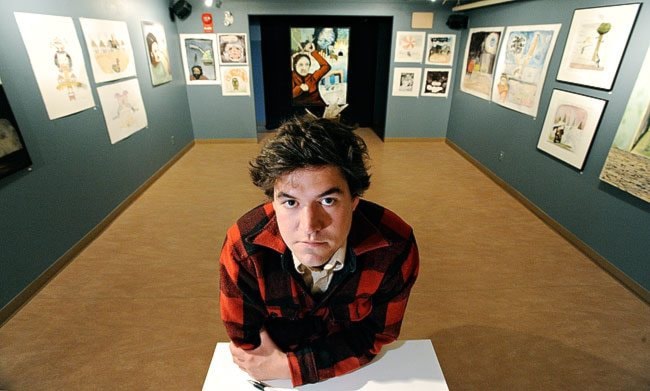Joseph Tisiga misspelled the name of his latest show.
So much the better, says the Whitehorse artist.
“I’m a sucker for serendipity,” he said. “It sounds better than what I wanted to say.”
The show, currently underway at Arts Underground, is called IBC Perge. IBC stands for Indian Brand Corporation, a fake moniker Tisiga introduced in an installation at the Yukon Arts Centre last year.
Perge is meant to say purge. The collection of paintings is styled as a blowout sale, as evident from the accompanying description on the show’s posters and pamphlets: “This is a thought market. Objects and wall hangings. Old and new. Injun and less Injun. Most everything must go.”
Tisiga was suitably horrified to catch the mistake after the publicity had been designed. Then he decided he’d better run the new word through Google.
It turned out perge is the Latin imperative for go on, proceed. Tisiga says that’s exactly what he’s trying to do.
But just where the 25-year-old is headed remains anyone’s guess. The collection is a hodgepodge of his unsold paintings of the past few years. Most follow what is, by now, a familiar theme for Tisiga: a jarring juxtaposition of stereotypical First Nations imagery and popular culture icons.
To wit: in two paintings, a Pepsi can is embellished with the ovoids and split-u forms that are hallmarks of West Coast First Nation art.
This awkward marriage helps express the dislocation of aboriginal people caught between two worlds - old and new - and not quite fitting in either.
More pointedly, in another painting a Thunderbird-headed figure shines a flashlight on two natives slumped near a dumpster, drinking. Elsewhere, a bottle of booze and a traditional raven figure duke it out in a homage to the popular videogame Street Fighter II.
Most of these paintings are several years old. Tisiga cringes at the sight of some.
“It’s me making these angry young man statements,” he said.
His newer work is more oblique. Anthropomorphic antler is an oil painting of a man holding a deer antler to his head. In one corner of the canvas is the parking lot of a big-box store. In another, a deer standing in a forest. Behind the deer: a cardboard cut-out of a bomb.
Tisiga struggles to explain the complexities of man’s alienation from nature and eventually gives up. Besides, he doesn’t like ascribing clear explanations to his art, preferring to let viewers draw their own conclusions.
“When I try to talk to people about it, it doesn’t make much sense,” said Tisiga. “It’s a way for me to imagine things and pose questions I wouldn’t otherwise be able to.”
Notably, the West Coast First Nation flourishes Tisiga frequently uses in his art doesn’t belong to his own Kaska culture.
He wonders aloud if one day this type of appropriation - already unthinkable for a non-native artist - will be permitted. Some First Nations want to patent their cultural hallmarks under intellectual property laws—bad news for a magpie like Tisiga.
The Indian Brand Corporation theme itself is a poke of sorts at the decision of First Nations to go corporate. He laments the idea of First Nations cashing in on mines and forestry at the expense of the natural world.
He acknowledges the jobs and wealth these industries bring will help “fix some things,” but he worries about the environmental sustainability of it all. These concerns have been expressed by Tisiga in past works that show Curious George pouring toxins into a river.
This anti-industrial commentary is not surprising, given Tisiga’s bohemian lifestyle. He has eked out a living from his art for the past two years without picking up a day job - largely thanks to a string of government grants, including a $20,000 prize from the Canada Council for the Arts last year.
Tisiga dropped out of high school at age 16 and later taught himself to paint. He offers this as an explanation for the inconsistency of his paintings on show.
This is especially evident in three watercolour paintings that depict, in a thinly veiled allegory, the enrolment of native children in residential schools.
Bears stand in for natives in the paintings while a raven plays the part of a missionary.
“Raven tricks bear with a whole lot of dead rabbits, then steals the cubs from under Bear’s nose,” text beneath the first scene explains.
“Raven’s gunna educate the cub and teach him how to fly. But the fool doesn’t know that bears will never fly.
“Finally bear tracks down that raven and is gonna take her back, and although she’s within full right to maul that fool to death she doesn’t.”
Between the three frames, the raven changes colour, from grey to blue and back to grey. The bears may or may not sport ovoid highlights. And their sizes change markedly.
Tisiga isn’t bothered by these discrepancies. He says there’s little effort on his part to enforce the kind of standardization that you’d find under a real corporate brand. He’s more interested in exploring new styles than fitting in any mold. “I’m not precious about this,” he said.
But it’s the unfinished, experimental quality of his art that leaves something to be desired when it’s held against Tisiga’s role models.
One is Brian Jungen, a British Columbian First Nations artist who became famous from a series of Haida masks built from torn-apart Nike Air Jordans. In another work, Jungen built a whale skeleton from a set of plastic lawn chairs.
Both Tisiga and Jungen plumb the same themes of native dislocation and hybrid identity. But while Jungen’s work is plain and spare, Tisiga’s often feels ragged and unfinished: more open to happy accidents like the exhibit’s title, certainly, but you can’t help but feel he’s yet to hit his potential.
The show continues until May 26.
Contact John Thompson at
johnt@yukon-news.com.
